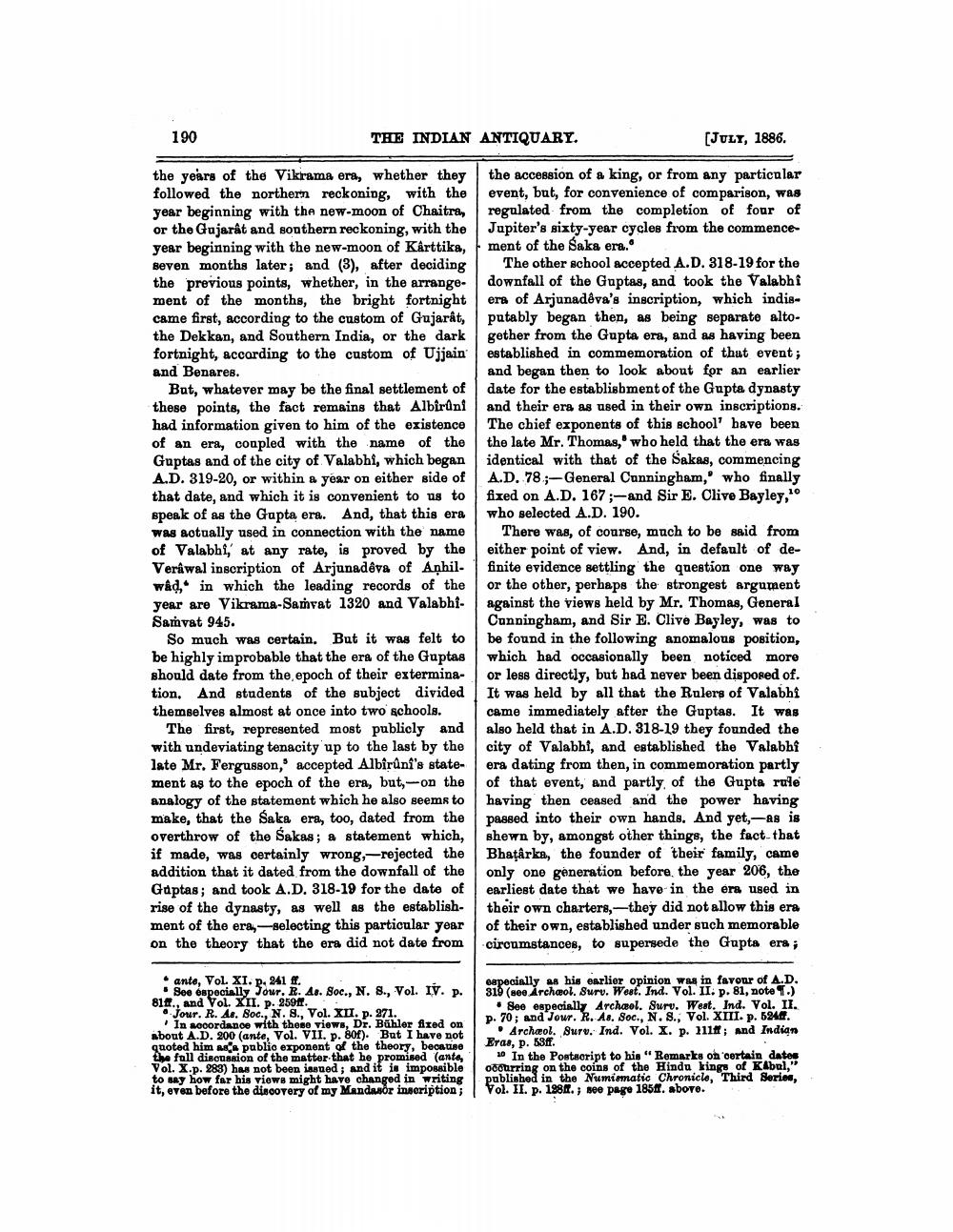________________
190
THE INDIAN ANTIQUARY.
(JULY, 1886.
the years of the Vikrama era, whether they the accession of a king, or from any particular followed the northern reckoning, with the event, but, for convenience of comparison, was year beginning with the new-moon of Chaitra, regulated from the completion of four of or the Gujarat and southern reckoning, with the Jupiter's sixty-year cycles from the commenceyear beginning with the new-moon of Kárttika, ment of the Saka era. seven months later; and (3), after deciding The other school accepted A.D. 318-19 for the the previous points, whether, in the arrange- downfall of the Guptas, and took the Valabhi ment of the months, the bright fortnight era of Arjunadeva's inscription, which indiscame first, according to the custom of Gujarat, putably began then, as being separate altothe Dekkan, and Southern India, or the dark gether from the Gupta era, and as having been fortnight, according to the custom of Ujjain established in commemoration of thut event; and Benares.
and began then to look about for an earlier But, whatever may be the final settlement of date for the establishment of the Gupta dynasty these points, the fact remains that Albiruni and their era as used in their own inscriptions. had information given to him of the existence The chief exponents of this school' bave been of an era, coupled with the name of the the late Mr. Thomas, who held that the era was Guptas and of the city of Valabhi, which began identical with that of the Sakas, commencing A.D. 319-20, or within a year on either side of A.D. 78;-General Cunningham,' who finally that date, and which it is convenient to us to fixed on A.D. 167 ;-and Sir E. Clive Bayley, 1° speak of as the Gupta era. And, that this era who selected A.D. 190. was actually used in connection with the name There was, of course, much to be said from of Valabhi, at any rate, is proved by the either point of view. And, in default of deVerkwal inscription of Arjunadeva of Anhil. finite evidence settling the question one way wad, in which the leading records of the or the other, perhaps the strongest argument year are Vikrama-Samrat 1320 and Valabhi- against the views held by Mr. Thomas, General Samvat 945.
Cunningham, and Sir E. Clive Bayley, was to So much was certain. But it was felt to be found in the following anomalous position, be highly improbable that the era of the Guptas which had occasionally been noticed more should date from the epoch of their extermina- or less directly, but had never been disposed of. tion. And students of the subject divided It was held by all that the Rulers of Valabhi themselves almost at once into two schools. came immediately after the Guptas. It was
The first, represented most publicly and also held that in A.D. 318-19 they founded the with undeviating tenacity up to the last by the city of Valabhi, and established the Valabhi late Mr. Fergusson, accepted Albiruni's state- era dating from then, in commemoration partly ment as to the epoch of the era, but-on the of that event, and partly, of the Gupta rule analogy of the statement which he also seems to having then ceased and the power having make, that the Saka era, too, dated from the passed into their own hands. And yet,-As is overthrow of the Sakas; a statement which, shewn by, amongst other things, the fact that if made, was certainly wrong.-rejected the Bhatarka, the founder of their family, came addition that it dated from the downfall of the only one generation before the year 206, the Guptas; and took A.D. 318-19 for the date of earliest date that we have in the era used in rise of the dynasty, as well as the establish their own charters,--they did not allow this era ment of the era, --selecting this particular year of their own, established under such memorable on the theory that the era did not date from circumstances, to supersede the Gupta era ;
• ante, Vol. XI. p. 241 ff.
See especially Four. R. As. Soc., N. 8., Vol. IV. p. 818., and Vol. XII. p. 2598. • Jour. R. Ar. Soc., N. 8., Vol. XII. p. 271.
In sooordance with these views, Dr. Bühler fired on about A.D. 200 (ante, Vol. VII. p. 80). But I have not quoted him as a public exponent of the theory, because the full discussion of the matter that he promised (ante, Vol. X.p. 283) has not been issued; and it is impossible to say how far his views might have changed in writing it, even before the discovery of my Mandosor inscription;
especially as his earlier opinion was in favour of A.D. 310 (808 Archæol. Suru. West. Ind. Vol. II. p. 81, note 1.)
• See especially Archæol. Suru. West. Ind. Vol. II. p. 70; and Jour. R. As. Soc., N. S., Vol. XIII. p. 524.
Archæol. Sury. Ind. Vol. X. p. 1118; and Indian Eras, p. 53ff.
20 In the Postscript to his "Remarks on certain dator occurring on the coins of the Hindu kings of Kabul," published in the Numismatic Chroniclo, Third Series, Vol. II. p. 1984. nee page 1851. above.




